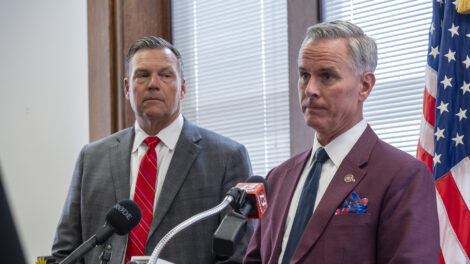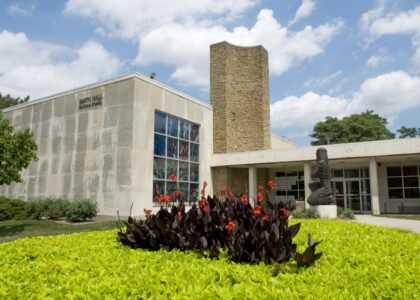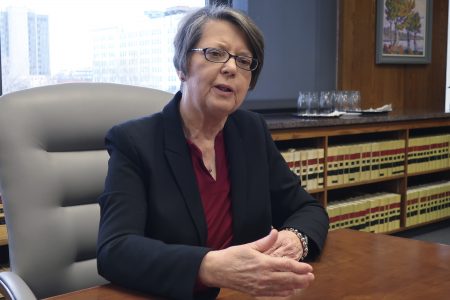Girod says a smaller workforce at KU will help the university improve pay for remaining employees
Chancellor doesn't have target number in mind for workforce size

photo by: Chad Lawhorn/Journal-World
University of Kansas Chancellor Douglas Girod listens to presentations at a ribbon cutting for an expansion of the Kansas Geological Survey on Nov. 6, 2025.
University of Kansas Chancellor Douglas Girod is uncertain how much a voluntary early retirement program for tenured faculty may reduce the size of KU’s workforce, but he does have one belief about the university’s workforce going forward.
“When you think about it, you do ultimately need to get to a smaller workforce if you are going to get to a better-paid workforce,” Girod said in a brief interview with the Journal-World this week.
KU leaders announced last month the voluntary early retirement program that will give eligible tenured employees a bonus equal to one year of their state salary, if they agree to retire in May. KU officials have said the program is part of the university’s efforts to find $32 million in annual budget savings by July 1.
This week, Girod reiterated what budget officials have previously said about those cuts: More than half of the $32 million in savings will be used to boost the pay of KU employees who are deemed to have wages below market rates.
If KU can feasibly operate with a somewhat smaller faculty, that would be one way of partially funding wage increases for other employees, Girod said. But he said KU must undertake such a plan in the right way.
“This is a way that you can respect people’s phenomenal contributions to the university, you can respect what they’ve done in their careers at the university, and maybe reward them financially at a time when they might be ready to move on anyway,” Girod said. “This is a way to do it in, I think, the most respectful way possible.”
Girod said he doesn’t have an idea of how many people will opt for the early retirement program. Interested faculty must express interest by Dec. 1. He also said he doesn’t have a target number in mind for how large KU’s faculty should ultimately be. He said he’s never found any broad metrics — such as this many faculty members per this many students — that have been very useful.
“I think we are just going to live our way through this and try to get to a place where we do what we absolutely have to do while we try to tighten up where we can,” Girod said.
Girod said there are no plans for university-wide layoffs to get to a certain workforce total at KU. However, he said some individual departments or units may decide to do some layoffs in order to meet their department/unit budget goals. Units are in the process of implementing new budget goals ahead of the July 1 deadline.
“Those decisions are going to get made a lot more at the unit level,” Girod said. “They are in a much better position to decide what they have to have and what is nice to have. There’s no ‘don’t need’ anymore. There really isn’t. We’ve taken care of that with 15 years of budget cuts. Now we are down to what’s nice to have but we can’t afford anymore, unfortunately.”
Any layoffs that would come likely would be in staff, administrative and other positions that don’t have the job protections that come with the rank of tenure. Girod said the university has no interest in suspending tenure protections, which generally isn’t allowed but has been a point of discussion among lawmakers.
“I mean tenure is foundational to who we are as a research university,” Girod said. “We would not be successful as a research university without that element of academic recognition … If we want the best and the brightest, that is the world we live in, and we are proud of that. It is not something we should run away from.”






